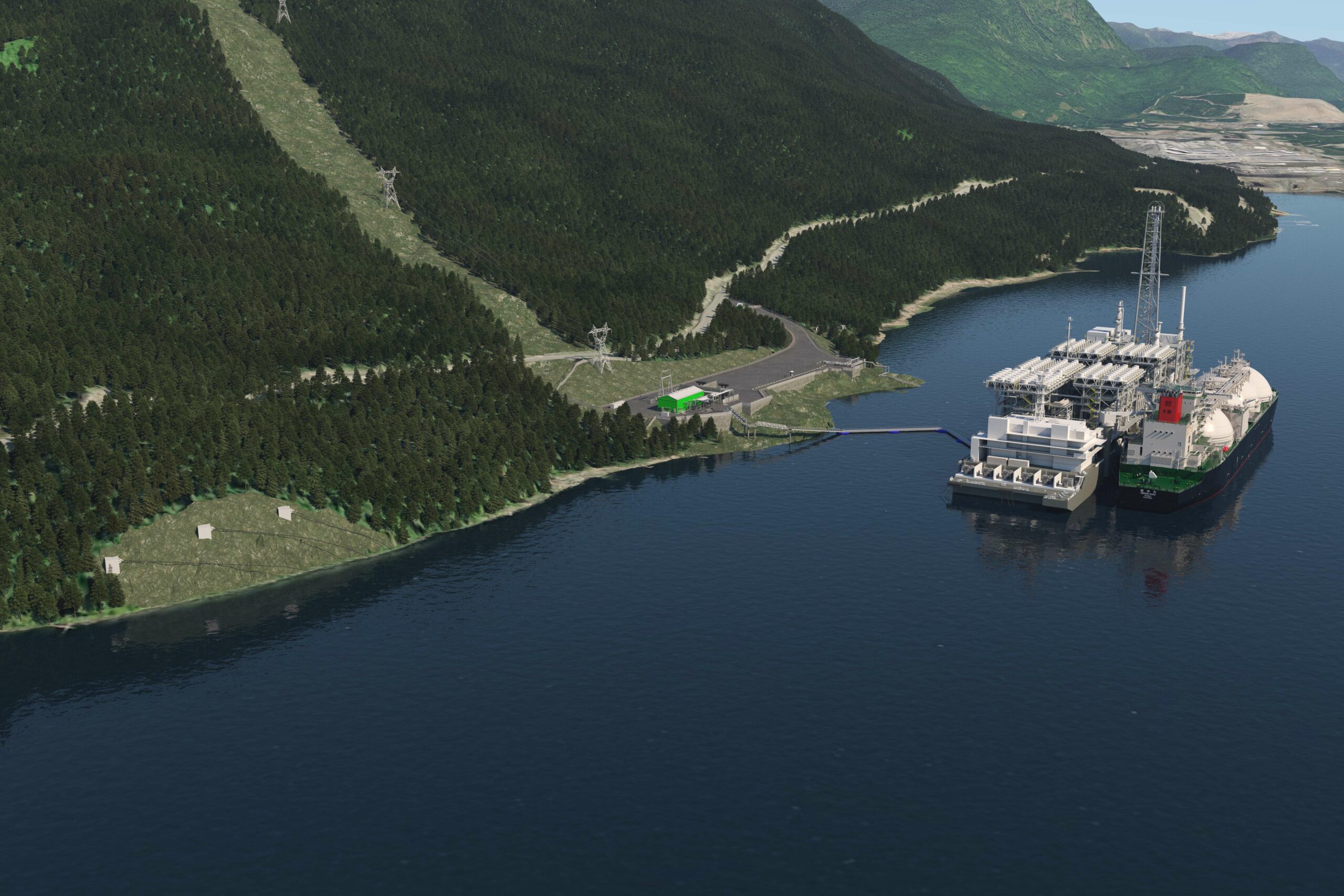[ad_1]
The Haisla Nation and Pembina Pipeline Corporation are going ahead with the Cedar LNG project in B.C., with a target time of late 2028 for starting operations and exports.
Crystal Smith, elected chief councillor of the Haisla, called it “trail-blazing a path for economic independence” for her nation.
And CEO Scott Burrows of Pembina said of the Final Investment Decision: “This is a historic moment, and we are proud to be moving forward with a project that will deliver industry-leading, low-carbon, cost-competitive Canadian LNG to overseas markets and contribute to global energy security, while delivering jobs and economic prosperity to the local region.”
Meanwhile, the Nisga’a Nation is getting set for construction to start August 24 on the rerouted PRGT pipeline that will feed natural gas to the nation’s Ksi Lisims LNG plant.
This week the Nisga’a Nation held community information sessions about employment on the Ksi Lisims project and the pipeline.
Cedar LNG will be the world’s first Indigenous-majority-owned LNG facility, with the Haisla Nation holding an interest of 50.1%, and Pembina 49.9%.
The floating Cedar plant will be able to produce some 3.3 million tonnes of LNG a year.
Some highlights from Cedar LNG’s news release:
- Cedar has made innovative design decisions to minimize the project’s environmental footprint and ensure it is one of the lowest-emitting LNG facilities in the world. One of the most important decisions was to power the facility with renewable electricity from B.C. Hydro.
- Prime Minister Trudeau hailed that power decision as meaning Cedar LNG will be “the world’s lowest carbon-footprint LNG facility.”
- B.C. Premier David Eby: “Cedar LNG is a shining example of how natural resource development should work in our province—in full partnership with First Nations and with the lowest emissions possible.”
- Under a long-term agreement, the Cedar LNG facility will receive 400 million cubic feet per day of Canadian natural gas via the Coastal GasLink pipeline.
- Cedar’s location provides one of the shortest shipping routes to key Asian markets. The Douglas Channel, leading to and from the site, offers an established, reliable shipping route and deepwater marine inlet, with year-round ice-free conditions.
- It has a total estimated cost of approximately US$4.0 billion (C$5.46 billion).
- The FLNG facility is being designed and constructed by Samsung Heavy Industries and Black & Veatch, global industry leaders in marine construction and FLNG solutions.
Karen Ogen of the First Nations LNG Alliance congratulated the Haisla and Pembina. “It shows how industry and Indigenous communities can work successfully together, partnering on the road to economic reconciliation. . . . It is truly historic.”
KSI LISIMS PLANS
For the Ksi Lisims project, TC Energy has announced construction will begin on its recently sold Prince Rupert Gas Transmission Pipeline (PRGT) project in August.
TC Energy is in the process of selling the pipeline to the Nisga’a Nation and Western LNG, a partner in the Ksi Lisims project. Terms have not been disclosed.
The original PRGT project received its environmental permit from B.C. in 2014, to carry natural gas from northeast B.C. to a planned Petronas LNG liquefaction facility near Prince Rupert.
The proposed Prince Rupert plant was shelved in 2017, but TC Energy (then known as Trans Canada Corporation) received a five-year extension to its pipeline permit in 2019.
That permit expires later this year, unless Ksi Lisims can show construction has “substantially started” by Nov. 25. The project now is aiming for that.
The PGT pipeline was originally proposed to exit from Nisga’a territory on the coast, turning south and going underwater to the Petronas plant facility near Prince Rupert. Now, instead of turning south, it would turn north, then run underwater to Ksi Lisims.
The undersea portion of the pipeline will be shorter than that originally proposed to reach the Prince Rupert plant.
In a story in The Terrace Standard, Rebecca Scott, Ksi Lisims LNG spokesperson, confirmed the timeline to start construction soon is partially based on the EAO requirement for that substantially started status by Nov. 25.
The other major factor, she said, is to align with timelines for the liquefaction facility because the pipeline will take longer to build. Ksi Lisims LNG expects to have permits in place for the plant by the end of the year. It now is in B.C.’s regulatory environmental assessment process.
Scott said Ksi Lisims is not overly concerned about permitting for the route change, which requires filing applications to the B.C. Environmental Assessment Offfice.
“Amendments are fairly common practices as projects with EA (environmental assessment) certificates evolve,” Scott said.
Ksi Lisims has said the project at Wil Milit will benefit Indigenous Nations and other communities in the region, but issues have been raised by the Gitanyow Hereditary Chiefs, the Lax Kw’alaams Band, and the Gitxsan Nation.
The Nisga’a and Gitanyow have launched a mediation process (although the Nisga’a release on that did not explicitly mention Ksi Lisims as an issue).
Scott told The Terrace Standard that initial construction activities this summer will not impact other Nations and that consultation work is ongoing.
“It is key to understand that the work will be happening on Nisga’a lands only,” she said. “It’s also very important to know that the work does not impact ongoing engagement with other nations about potential improvements and benefits.”
Nisga’a Nation president Eva Clayton said she believes all the concerns will be worked out as the projects progress.
“When we announced that we were buying this project, we knew it represented a historic and meaningful step toward independence and opportunity — not just for the Nisga’a, but for all Indigenous people in Canada.”
Cedar LNG plant (artist’s rendering)

(Posted here 26 June 2024)
[ad_2]
Source link
